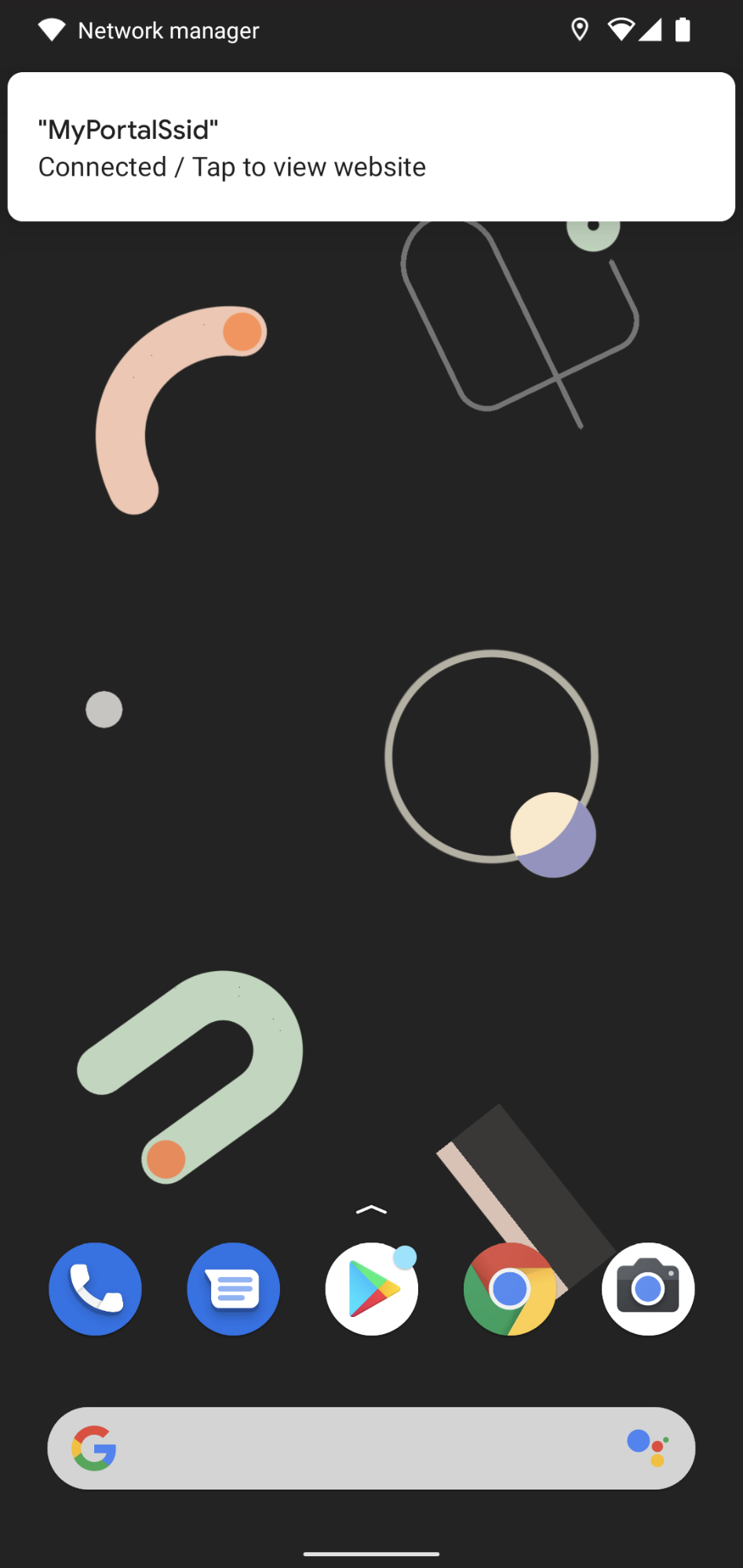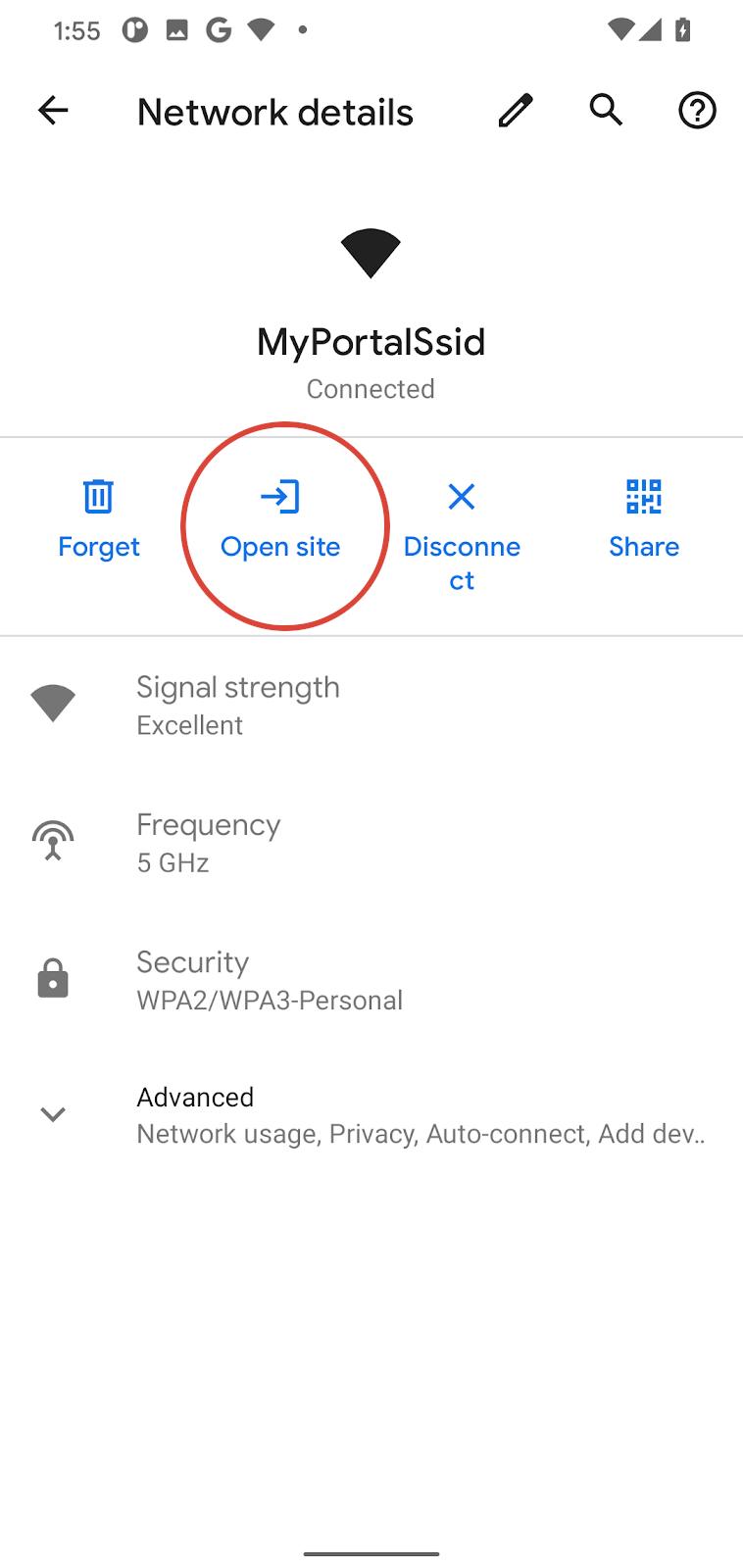ตั้งแต่ Android 11 Beta 2 เป็นต้นไป ระบบจะรองรับฟังก์ชันการทำงานบางส่วนที่อธิบายไว้ใน RFC7710bis และ API พอร์ทัลที่ต้องมีการตรวจสอบสิทธิ์ก่อนเข้าถึงอินเทอร์เน็ตที่เกี่ยวข้อง
API เป็นวิธีที่เชื่อถือได้สำหรับจุดเข้าถึงในการระบุตัวเองว่าเป็นแคปทีฟพอร์ทัล นอกจากนี้ยังช่วยให้เกิดกรณีการใช้งานใหม่ๆ สำหรับจุดเข้าถึงในการเผยแพร่ ข้อมูลแก่ผู้ใช้ เช่น ข้อมูลเซสชันและสถานที่
ปรับปรุงการตรวจหาแคปทีฟพอร์ทัล
ตั้งแต่ Android 5.0 (API ระดับ 21) เป็นต้นมา อุปกรณ์ Android จะตรวจหาแคปทีฟพอร์ทัล
และแจ้งให้ผู้ใช้ทราบว่าต้องลงชื่อเข้าใช้เครือข่ายเพื่อเข้าถึง
อินเทอร์เน็ต ระบบตรวจพบแคพทีฟพอร์ทัลโดยใช้การตรวจสอบ HTTP แบบข้อความธรรมดาไปยังปลายทางที่รู้จัก (เช่น connectivitycheck.gstatic.com) และหากการตรวจสอบได้รับการเปลี่ยนเส้นทาง HTTP อุปกรณ์จะถือว่าเครือข่ายเป็นแคพทีฟพอร์ทัล เทคนิคนี้อาจไม่น่าเชื่อถือเนื่องจากไม่มี URL มาตรฐานสำหรับ
การตรวจสอบ และเครือข่ายแคปทีฟพอร์ทัลอาจอนุญาตหรือบล็อกการตรวจสอบดังกล่าวโดยไม่ได้ตั้งใจ (แทนที่จะ
เปลี่ยนเส้นทาง) API ช่วยให้พอร์ทัลระบุ
สัญญาณเชิงบวกที่ระบุว่าต้องมีการเข้าสู่ระบบ พร้อมกับ URL สำหรับเข้าสู่ระบบ
Android 11 รองรับตัวเลือก DHCP 114 ตามที่อธิบายไว้ใน RFC7710bis เราอาจเพิ่มการรองรับตัวเลือกการโฆษณาเราเตอร์ในการอัปเดตในอนาคต หาก อุปกรณ์ได้รับ URL ของ Captive Portal API ผ่านตัวเลือกดังกล่าวระหว่างการแฮนด์เชค DHCP อุปกรณ์จะดึงข้อมูล API ทันทีหลังจากเชื่อมต่อและ แจ้งให้ผู้ใช้เข้าสู่ระบบหากเครือข่ายเป็นแบบ Captive ตาม Captive Portal API
หาก API ไม่พร้อมใช้งานหรือไม่มีการโฆษณาพอร์ทัล ระบบจะ ตรวจหาพอร์ทัลและยืนยันการเชื่อมต่ออินเทอร์เน็ตโดยใช้โพรบ HTTP/HTTPS ต่อไป เช่นเดียวกับก่อนหน้านี้
ข้อมูลที่เผยแพร่ในสถานที่
Android 11 รองรับ venue-info-url ที่กำหนดไว้ใน API พอร์ทัลที่ต้องมีการตรวจสอบสิทธิ์
ก่อน URL นี้ช่วยให้ผู้ใช้ได้รับข้อมูลที่เฉพาะเจาะจงตามบริบทเกี่ยวกับ
สถานที่ตั้งของจุดเข้าถึงในเบราว์เซอร์ โดยค่าเริ่มต้น ผู้ใช้จะเปิด URL นี้ได้หากเลือกที่จะทำเช่นนั้นจากการแจ้งเตือนหลังจากเข้าสู่ระบบ หรือจากการตั้งค่าเครือข่าย

รูปที่ 1 หากเครือข่ายระบุ URL ของสถานที่ ระบบจะแสดงข้อความแจ้ง
เพื่อให้ผู้ใช้เข้าชมหน้านั้นได้

รูปที่ 2 ปุ่มสำหรับเปิดเว็บไซต์จากหน้าจอรายละเอียดเครือข่าย
กรณีการใช้งานในอนาคต
แม้ว่าในตอนเปิดตัว Android 11 จะรองรับฟังก์ชันพื้นฐานจาก Captive Portal API เท่านั้น แต่ฟังก์ชันใหม่ๆ อาจได้รับการเผยแพร่ไปยังอุปกรณ์ผ่านการอัปเดตระบบ Google Play หลังการเปิดตัว เราขอแนะนำให้ผู้ให้บริการเครือข่าย ใช้ Captive Portal API โดยคำนึงถึงการปรับปรุงที่อาจเกิดขึ้นในอนาคต
- ปัจจุบันระบบใช้เวลาเซสชัน (
seconds-remaining) ในแอปการตั้งค่าเริ่มต้นเพื่อแจ้งให้ผู้ใช้ทราบว่าเหลือเวลาเท่าใดในพอร์ทัล ความสามารถในการขยายเซสชันผ่าน URL การเข้าสู่ระบบ (can-extend-session) สามารถแสดงผ่าน API เพื่ออนุญาตให้ระบบแจ้งเตือนผู้ใช้เกี่ยวกับเซสชันที่หมดอายุหรือกำลังจะหมดอายุได้ด้วย - โควต้าข้อมูล (
bytes-remaining) สามารถโฆษณาผ่าน API เพื่อให้ผู้ใช้ติดตามข้อมูลที่เหลือได้

